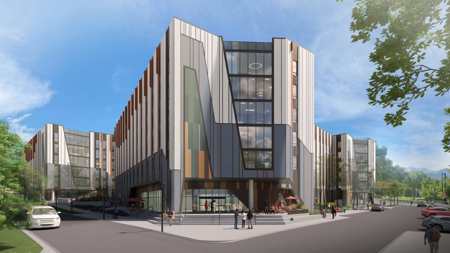
University of Utah
American Campus Communities
The University of Utah’s new student housing development, slated for occupancy in Fall 2026, exemplifies the power and potential of public-private partnerships (P3s) in higher education. Delivered in collaboration with American Campus Communities (ACC), this initiative introduces an innovative, risk-mitigated and student-focused approach to campus development that aligns with the university’s broader goal of transforming into a traditional, residential college experience. It delivers not only critical bed space for 1,400 students but also a high-quality, sustainable and community-oriented living environment that will shape the campus for decades to come. Innovation in Procurement, Structure, Finance and Delivery This project, the university’s first ever P3 housing development, represents a cutting-edge example of how institutions can creatively leverage P3 models to meet evolving student housing demands without incurring new debt or compromising academic budgets. Through ACC’s American Campus Equity (ACE) program, the university retained valuable capital for other institutional priorities while gaining a best-in-class housing complex tailored to its unique needs. Under the ACE program, ACC assumes full financial responsibility while allowing the university to maintain strategic control over programming and design. This arrangement ensures asset delivery without a financial burden on the institution. Additionally, the agreement includes a 55-year ground lease with two 10-year extension options, ensuring long-term alignment of interests while keeping ownership of the land with the University. ACC is leading development with local partners MHTN Architects and Okland Construction, combining national expertise with community-rooted execution for localized design excellence. Effective Risk Assessment and Transfer In choosing a P3 delivery model, the University of Utah has effectively transferred key development and operational risks, including financial and construction-related risks, to ACC. ACC, along with Okland Construction, carries full responsibility for delivery within scope, budget and timeline parameters, protecting the University from volatility in costs, materials and labor. ACC will also operate and maintain the residence hall for the duration of the lease term, ensuring consistent quality and freeing university resources for academic and student support functions. Through a leasehold interest, ACC takes on the risk associated with occupancy and rent collection, further insulating the University of Utah from the uncertainties of housing market fluctuations. This structured and strategic risk allocation enables the university to benefit from expanded housing capacity without financial or reputational exposure to traditional development risks. Meeting and Exceeding Project Milestones Despite broader economic headwinds, including rising construction costs and supply chain challenges, the project has already reached major milestones ahead of schedule. The official groundbreaking took place on January 29, 2025, marking the start of the project. The financial close was successfully achieved, backed by ACC’s capital and Blackstone’s institutional support, a significant milestone ensuring project viability and timely delivery. Finally, design and programming phases have advanced efficiently through close collaboration among the University of Utah, ACC, MHTN Architects and student life leadership. The delivery team is aligned and mobilized, setting a pace and performance standard that instills confidence in a timely and budget-conscious completion. Design Quality, Sustainability and Environmental Measures The residence hall is designed to reflect Utah’s natural beauty and the university’s sustainability mission. Featuring nearly 350,000 square feet across six stories, the building is not just a place to live, but a purpose-built, community-centered environment that inspires academic success, personal well-being for students and environmental responsibility. In terms of design, the building’s aesthetic and functional elements make up the community’s nature-inspired architecture, celebrating Utah’s outdoor lifestyle. Sustainability was seamlessly integrated into the residence’s plan, with features such as green construction methods, indoor bike storage and repair areas, ski and snowboard lockers, rainwater management systems and energy-efficient systems. The project is being built with long-term sustainability and environmental performance in mind, aligned with future LEED certification pathways. This sustainable focus not only reduces environmental impact but also promotes cost-effective, long-term operations and a healthier living experience for residents. Flexibility and Alternative Asset Use The residence hall is designed with adaptability at its core. Its robust amenity program ensures multi-purpose functionality, allowing the space to serve a range of future student and institutional needs. These built-in flexibilities ensure the asset continues to serve evolving institutional and student demands over decades: Dining and Fitness Centers: Multi-use spaces on the first floor encourage social engagement, wellness and community programming. Social Hubs and Outdoor Amenities: Indoor bouldering walls, hammocks, lawn games and excursion planning areas reflect an evolving student lifestyle and support year-round use. Resilient Design: The building can evolve to accommodate future programming needs or even alternate institutional purposes over its 75-year lifecycle. Social Impact and Community Transformation This project represents a profound social shift for the University of Utah. Historically known as a commuter campus, the university is transforming into a fully residential institution where student success is fostered both in the classroom and through community immersion and on-campus living. Transformative impacts include student retention and success, as studies consistently show that residential students experience higher graduation rates. By housing first- and second-year students, the project promotes continuity, belonging and engagement. Diversity and equity remain at the forefront as students from lower-income backgrounds cite affordable campus housing as key to staying enrolled, accessing resources and building mentorship networks. This project is part of a broader institutional goal to reach 40,000 enrolled students, many of whom will live on campus, creating a vibrant, connected, 24/7 community. The new residence hall is more than an infrastructure – it is a catalyst for cultural transformation, shaping the future of student life at the University of Utah. Delivering Results & Ensuring Success This student housing development is a masterclass in modern P3 delivery. Through its innovative financing, effective risk transfer, timely milestone achievement, sustainable and inclusive design, and profound social impact, the project delivers far more than beds. The result is a replicable model for institutions nationwide seeking to transform their student experience while protecting institutional resources and upholding the highest standards of design, delivery and equity.